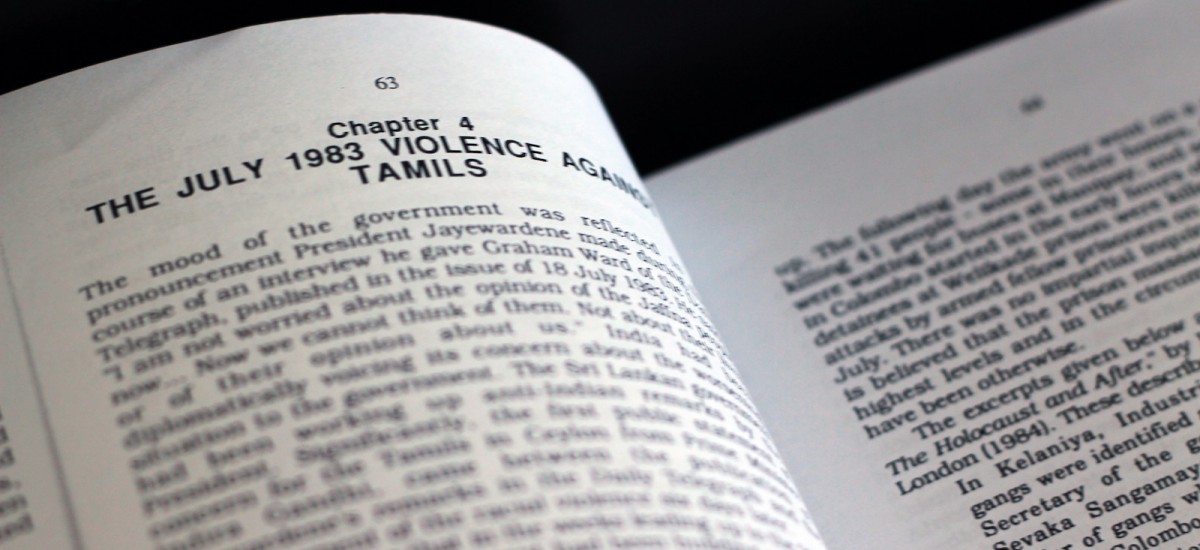To complement the launch of 30 Years Ago and focus on some of the issues the project is anchored to and inspired by, readers of Groundviews are cordially invited to attend four panel discussions on the 24th and 25th of August at Park Street Mews, Warehouse D in Colombo.
We are particularly pleased to highlight the inaugural session, featuring Deshamanya Bradman Weerakoon and Dr. Devanesan Nesiah, both of whom have been featured on Groundviews previously writing or speaking about Black July (see here and here). This is the very first time they are appearing together to talk about their unique experiences around the violence in 1983. The other panels feature some of the Sri Lanka’s best known artists, gallerists, writers, dramatists, activists and journalists.
All events are free to attend. Limited, unreserved seating will be available. All the sessions will be recorded at broadcast quality for posterity and subsequently featured on the 30 Years Ago website.
24th August, 10am – 11am
Reflections of ’83: Plus ça change?
As Sri Lanka’s first Commissioner General of Essential Services (CGES) Mr. Weerakoon has unique perspectives to share around the violence in July, its aftermath and lasting impact. Dr. Nesiah was a public servant for over 35 years. As Government Agent (GA) and District Secretary (DS) of Jaffna, he was involved with the care of around 60,000 victims who moved into Jaffna in the days and weeks following the pogrom. Both speakers will present for around 20 minutes each, followed by Q&A.
Featuring Deshamanya Bradman Weerakoon and Dr. Devanesan Nesiah
Moderated by Dr. Paikiasothy Saravanamuttu
24th August, 4pm – 5pm
Art and Memorialising
How has art in Sri Lanka since ’83 struggled with the politics of remembrance – the depiction of inconvenient truths, recalling and critiquing that which mainstream politics seeks to forget and erase? What role can and does art in general play in memorialising violent events, and how has this played out in our country? More generally, what is the role of art in interrogating a violent past? What comparable examples are there of art in other regions and contexts that have served to memorialise trauma (e.g. Berlin’s holocaust memorial)
Featuring Saskia Fernando, Ameena Hussein, Jagath Weerasinghe and Chandragupta Thenuwara
Moderated by Tracy Holsinger
25th August, 10am – 11am
Frames
How do we see our past, and thereby choose to learn from or repeat that which gave rise to violence? In framing histories, what are the politics of selection and exclusion? In a country where the single story often wins out against multiple truths, in looking back at the past, how do we capture the marginal, the violently erased, the inconvenient? How do we, in other words, frame our past to understand our present, and shape our future? The four speakers will approach the topic with different perspectives, ranging from photography and literary criticism to activism and film.
Featuring Ruhanie Perera, Anushka Wijesinha and Ruki Fernando
Moderated by Subha Wijesiriwardena
25th August, 4pm – 5pm
Media matters
How did the media cover 1983, and why is it so difficult to find archival material on this coverage? How can and should media reflect on Black July 30 years since, in light of more contemporary events and politics? How can acts of journalism help record the moment for posterity, even by those who are involved in the violence as victim or perpetrator? Are there lessons for journalism and media from the violence of ’83?
Featuring Dilrukshi Handunetti, Nalaka Gunawardene and Feizal Samath
Moderated by Sanjana Hattotuwa

